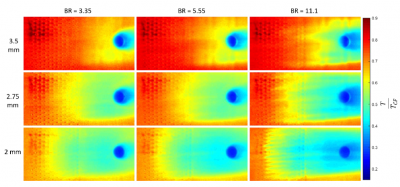Sponsor: Pratt & Whitney
Project Summary:
This project uses an experimental combustion rig to analyze the heat transfer characteristics of effusion cooling. The analysis is performed for a range of blowing ratios with various effusion cooling designs to obtain surface temperature images and planar gas temperature images. A premixed propane air mixture with an equivalence ratio of 0.865 is combusted to generate a hot, vitiated crossflow with a bulk temperature ~1500 K. A test section designed with three side optical access mounts plates with various effusion cooling configurations. Infrared (IR) thermography is used for front and backside temperature imaging of the effusion plate. Front side temperature imaging is used to quantify cooling effectiveness, Fig. 1. Paired front and backside temperature images are used to generate heat flux distributions across the effusion cooled plate. Laser Rayleigh scattering (LRS), utilizing a 10 Hz 355 nm laser sheet, provides planar gas temperature images at multiple heights above the surface of the effusion plate, Fig. 2. LRS gas temperature images can be used to characterize film development and stability. IR surface temperature images with corresponding heat flux distributions are matched with LRS gas temperature images to quantify heat transfer coefficients and calculate a Nusselt value. The thermal characteristics are critical in assessing the cooling performance of effusion cooling designs and validating CFD models of combustor gas dynamics.

Fig. 1 Cooling effectiveness distributions for two effusion configurations (A and B) at low and high blowing ratios

Fig 2. Average temperature distributions for blowing ratios 3.35, 5.55, 11.1, at heights 2 mm, 2.75 mm, 3.5 mm